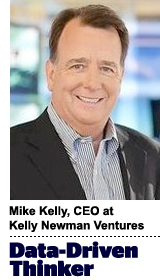 “Data-Driven Thinking” is written by members of the media community and contains fresh ideas on the digital revolution in media.
“Data-Driven Thinking” is written by members of the media community and contains fresh ideas on the digital revolution in media.
Today’s column is written by Mike Kelly, CEO at Kelly Newman Ventures.
In 2016, non-tech companies bought more tech companies than ever before. According to Bloomberg, 682 technology firms were purchased by companies in an industry other than technology, while 655 businesses were purchased by pure-play technology companies.
This is a big shift, as major technology players used to dominate the M&A landscape. Powerhouses such as IBM, Microsoft, Oracle and Google, to name a few, used their high revenue multiples and large cash reserves to buy competitors, extensions or new capabilities. These acquisitions were often accretive and helped maintain strong revenue growth.
Now, non-technology companies, seeing their industries transformed by innovation, are looking for ways to keep up and play offense. They simply do not have the culture or expertise to build these capabilities in-house.
This is arguably more prevalent in the ad tech industry than anywhere else. As technology continues to develop and change the way media is consumed, advertising companies must adapt new technologies to keep up. This landscape changes constantly as new, more efficient methods are developed.
Legacy companies in the ad tech industry realize that to remain competitive, they must become a one-stop shop for all the services an advertiser needs. For that reason, we are seeing more M&As in the advertising industry than ever.
Some recent examples of this type of acquisition include Rubicon Project’s purchase of nToggle, aimed at creating an all-in-one platform for automated ad buying and header-bidding optimization. Another example is Sizmek’s acquisition of Rocket Fuel, which created one of the largest independent marketing platforms available. In both cases, the companies were able to quickly adopt and offer a wider array of services by acquiring a company that offered a niche technological service, as opposed to trying to develop the capabilities in-house from scratch.
The evolution of artificial intelligence, smart devices and mobile computing promises to transform every sector in the market from media and advertising to transportation, finance, manufacturing and even health care. The pace of technological innovation is only speeding up, forcing non-tech incumbents to act.
There are different approaches that the incumbents have used to take advantage of these changes. Some, like General Motors, have invested in startups like Lyft. These startups benefit from the capital, but also from the exposure and expertise. The incumbents get a potential home-run return.
Investing, however, will rarely transform a company. For that, often an acquisition or many is required. Culture, capabilities and reputation need to be changed quickly since technology is moving at a rapid pace.
Amazon and Snapchat both created features to standardize existing advertisements for their platforms. Google created ad-blocking tools to set a higher standard of the types of ads allowed on its pages. These examples were bold, large entrées into new ways of advertising.
For smaller companies to compete with the goliaths, acquisitions can offer the quickest way to scale to a competitive size. However, acquisitions are hard to execute and often fail.
Transformative acquisitions are the toughest because it is not simply vertical integration or consolidating in the same industry. These mergers are all about buying the future and keeping up with industry change. Over time, we have seen what makes an acquisition and its integration transformative and successful, changing the acquirer into a leader.
While time will tell whether certain acquisitions transformed the acquirer, there are patterns and rules of thumb that help companies beat the odds.
Goldilocks
The size has to be just right. That generally means large, but not too large. Incumbents by definition are large and deliberate. Transformation is about shaking things up and changing culture. Companies often err by buying small technology capabilities hoping that they can catalyze the change, only to find that they do not have the gravitational mass to be that catalyst. The focus and investment required to continue their growth will also not be sufficient.
The success of the acquisition has to be material to the ongoing business – there is no hard and fast rule – but material enough so that it can change the growth trajectory. By the same token, merger of equals for transformation is almost impossible. A fight for control and dominance distracts from successful integration. The AOL and Time Warner merger is the classic example of this pitfall.
Respect
A transformational merger is about bringing a catalyst culture into contact with a more traditional one. But it only works when both companies share the same broad values and respect the achievements of the other.
Dollar Shave Club and Unilever are great examples of this. Both value creating lasting consumer brands. How can the team at Dollar Shave Club not value and respect the great brands that Unilever has built and bought? Similarly, the Unilever team must be impressed with how Dollar Shave Club built its brand: in a unique and transformative way, direct to consumer and at unprecedented speed.
There are plenty of examples where the other side feels that the other company does not “get it” or “has ruined its legacy” – these mergers rarely work.
Integration
A careful and well-paced integration plan is critical. Even if you get the right size and the right culture, moving too fast will kill the mergers, and the expected transformation will fall flat. Change is scary and threatening. Fear dominates the first year or two of any merger. It is imperative that trust be established by empowering the existing leaders of the acquired company. Giving the acquired company the explicit challenge of introducing change and new ways of thinking is imperative.
Disney and Pixar, WPP and Saatchi & Saatchi, P&G and Gillette and Comcast-NBC are some successful transformative acquisitions that illustrate these rules of thumb.
This is the new reality. Expect M&A for technology companies to continue to skew toward non-technology incumbents. For those that want to transform, the path is tough but not impossible. The greatest companies know when to make the leap.
Follow AdExchanger (@adexchanger) on Twitter.














